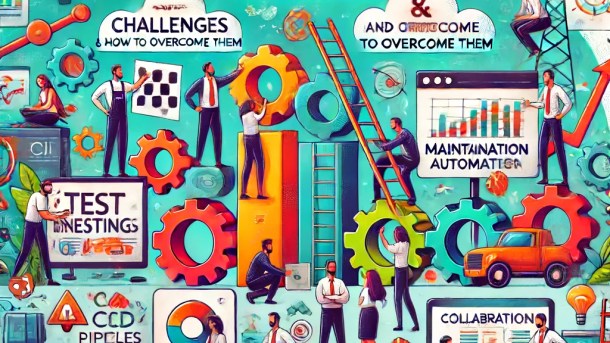In the world of Agile and DevOps, where software teams are constantly pushing the boundaries of speed and innovation, ensuring quality can often feel like an uphill battle. But what if quality wasn’t an afterthought, but rather an integral part of the development process itself? This is the promise of DevQAOps, and while the potential is immense, it’s important to acknowledge that the journey towards this new paradigm can be fraught with challenges.
This comprehensive guide explores the common challenges that organizations face when adopting DevQAOps and offers actionable solutions to navigate them successfully. By understanding and addressing these challenges head-on, teams can unlock the full potential of DevQAOps and achieve a harmonious blend of rapid delivery and exceptional software quality.
1. Cultural Resistance: The Battle for Change
One of the most significant challenges in DevQAOps adoption is cultural resistance. Traditional organizational structures often foster silos between development, QA, and operations teams, leading to communication breakdowns and misaligned priorities. This can create a breeding ground for resistance to change, as team members may be hesitant to embrace new ways of working and collaborating.
Solutions:
- Lead by Example: Leadership plays a crucial role in driving cultural change. When leaders actively champion DevQAOps and demonstrate its value through their actions, it can inspire others to follow suit.
- Communication and Education: Clearly communicate the benefits of DevQAOps to all stakeholders, emphasizing how it can improve efficiency, quality, and collaboration. Provide training and workshops to help team members understand the new processes and tools involved.
- Foster a Culture of Collaboration: Encourage open communication, knowledge sharing, and cross-functional collaboration. Break down silos by creating opportunities for teams to work together on shared goals.
- Celebrate Success: Recognize and celebrate small wins along the way. This reinforces the value of DevQAOps and motivates team members to continue embracing the change.
2. Skill Gaps: Bridging the Knowledge Divide
DevQAOps requires a diverse skill set that spans development, QA, and operations. However, not all team members may possess the necessary expertise in areas like test automation, infrastructure as code, or continuous integration and delivery. This skills gap can hinder the successful implementation of DevQAOps practices.
Solutions:
- Invest in Training and Development: Provide comprehensive training programs to equip team members with the required skills. This can include formal courses, workshops, mentoring programs, and hands-on learning opportunities.
- Encourage Continuous Learning: Foster a culture of continuous learning where team members are encouraged to explore new technologies, tools, and methodologies. This can be achieved through online courses, conferences, and knowledge-sharing sessions.
- Hire for DevQAOps Expertise: Consider hiring individuals with specific expertise in DevQAOps practices and tools. These experts can act as mentors and guides, helping the rest of the team upskill and adapt to the new approach.
3. Tool Integration and Complexity: Taming the Tech Stack
The DevQAOps landscape is rich with tools and technologies, each serving a specific purpose in the development and QA process. However, integrating these disparate tools into a cohesive and efficient workflow can be a daunting task. The complexity of managing multiple tools can lead to overhead, integration challenges, and potential points of failure.
Solutions:
- Choose the Right Tools: Carefully evaluate and select tools that align with your organization’s specific needs and technology stack. Prioritize tools that offer seamless integration with each other and with your existing development and operations infrastructure.
- Adopt a Platform Approach: Consider using a unified DevQAOps platform that integrates various tools and services into a single, cohesive environment. This can simplify tool management, streamline workflows, and reduce the risk of integration issues.
- Leverage Cloud-Native Solutions: Cloud-based DevQAOps platforms offer scalability, flexibility, and ease of deployment, eliminating the need for complex on-premises infrastructure.
- Streamline Workflows: Automate as many processes as possible, from test execution to deployment and monitoring. This reduces manual effort, minimizes errors, and frees up team members to focus on more strategic tasks.
4. Test Environment Management: Replicating Real-World Scenarios
Creating and maintaining realistic test environments that mirror production environments is crucial for ensuring the reliability and performance of software in the real world. However, managing test environments can be a complex and time-consuming task, especially in cloud-native or microservices-based architectures.
Solutions:
- Infrastructure as Code (IaC): Adopt IaC practices to define and manage your test environments as code. This ensures consistency, reproducibility, and scalability, making it easier to create and tear down environments on demand.
- Containerization: Leverage container technologies like Docker to package your applications and their dependencies into portable, self-contained units. This simplifies environment setup and ensures consistent behavior across different environments.
- Service Virtualization: Use service virtualization tools to simulate the behavior of dependent systems and services that may not be readily available for testing. This helps avoid delays and reduces the reliance on external dependencies.
- Cloud-Based Test Environments: Consider using cloud-based testing platforms that offer on-demand access to pre-configured environments, eliminating the need to build and maintain your own infrastructure.
5. Security Concerns: Protecting Your Assets
In the age of increasing cyber threats, security is a top priority for any organization. DevQAOps introduces new security challenges, as it involves integrating QA into the development pipeline, which can potentially expose vulnerabilities if not managed properly.
Solutions:
- Security as Code (SaC): Apply SaC practices to embed security controls into your development and deployment processes. This helps ensure that security is not an afterthought but an integral part of the software development lifecycle.
- DevSecOps: Embrace DevSecOps principles, which involve integrating security practices into the DevOps workflow. This includes security testing, vulnerability scanning, and threat modeling throughout the development process.
- Secure Test Data Management: Ensure that sensitive test data is properly masked or anonymized to protect privacy and comply with regulations.
- Regular Security Audits: Conduct regular security audits and penetration tests to identify and address potential vulnerabilities in your systems and processes.
6. Scaling DevQAOps: Growing with Your Organization
As organizations grow and software projects become more complex, scaling DevQAOps practices can be a significant challenge. Maintaining efficiency, quality, and collaboration across larger teams and projects requires careful planning and adaptation.
Solutions:
- Modular Architecture: Design your software with a modular architecture that allows for independent testing and deployment of individual components. This makes it easier to scale testing efforts and isolate issues.
- Microservices: Consider adopting a microservices architecture, where applications are built as a collection of small, independent services. This can improve scalability and resilience, as individual services can be updated and tested independently.
- Distributed Testing: Use distributed testing frameworks to run tests in parallel across multiple machines or cloud environments. This can significantly reduce test execution time and improve scalability.
- Scalable Tools and Platforms: Choose tools and platforms that are designed to scale with your organization’s growth. This may include cloud-based solutions that offer on-demand resources and elastic scaling.
7. Measuring and Demonstrating Value: Proving the ROI
One of the most common challenges in adopting any new methodology is demonstrating its value to stakeholders. This is especially true for DevQAOps, where the benefits may not always be immediately apparent.
Solutions:
- Define Clear Metrics: Establish clear and measurable metrics that align with your organization’s goals. These metrics should track both the efficiency and effectiveness of your DevQAOps practices.
- Track Progress: Regularly monitor and report on your metrics to demonstrate the progress you’re making. This will help build confidence in DevQAOps and secure ongoing support from stakeholders.
- Communicate Success Stories: Share success stories and case studies that highlight the positive impact of DevQAOps on your projects. This can help create a culture of appreciation for QA and its role in software delivery.
- Focus on Business Outcomes: Tie your DevQAOps metrics to tangible business outcomes, such as faster time to market, reduced costs, and improved customer satisfaction. This will demonstrate the value of DevQAOps in a language that stakeholders understand.
By understanding and addressing these challenges head-on, organizations can unlock the full potential of DevQAOps and achieve a harmonious blend of rapid delivery and exceptional software quality.



















